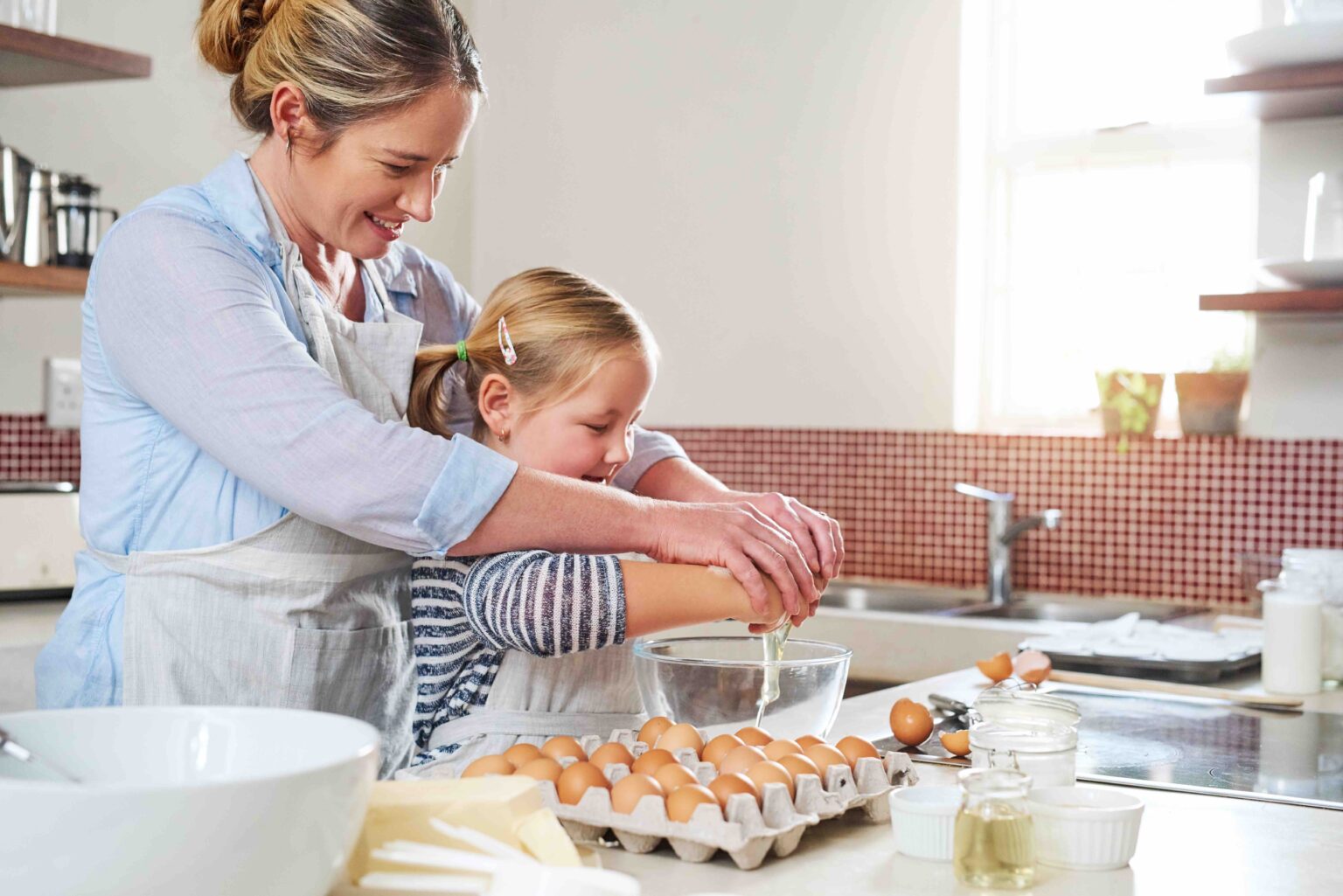
Canada’s food guide emphasizes that kids learn about food skills and the importance of healthy eating when they are involved in meal planning and preparation. Research has shown that food-related attitudes, preferences and behaviours in kids have been highlighted as characteristics that can be improved by getting kids involved in meal preparation. Your kids can also learn about the importance of washing their hands properly before, during and after preparing food and how to clean up after themselves when the cooking is done.
Eggs make a great starting point for kids to participate in the kitchen! They can be cracked, whisked, separated, boiled, fried and incorporated into many recipes. The possibilities are endless!
Apart from being so versatile in the kitchen, eggs offer health benefits for your kids too, to help them grow up strong and healthy. Eggs are an excellent source of protein, and also contain fat, choline, vitamins A, D, E and B12. Two eggs contain 13 grams of high-quality protein and will help your child stay full, focused and energized throughout the day. Choline will help support your child’s brain development and health.
Did you know that introducing whole eggs early on into your child’s diet can reduce their risk of developing an egg allergy? That’s one of the reasons why the most recent infant feeding recommendations issued by Health Canada, the Canadian Pediatric Society, the Breastfeeding Committee for Canada and Dietitians of Canada advise introducing whole eggs as soon as your baby reaches six months of age or begins eating solid foods.
Tips for getting your kids in the kitchen:
Here are some tips to get your children interested in food prep:
-
- Create the menu together. Go through cookbooks and websites together and let them choose what they want to make.
-
- Invite your kid into the kitchen while you’re cooking. This allows your kids to become familiar with your kitchen environment.
- Give them their own cooking station and tools. Create a kid-friendly workspace in the kitchen that is both accessible and safe. Whenever they enter the kitchen, they have their own area and special mixing spoon or set of measuring cups to use.
- Taste everything. While cooking, you can talk to your kids about the different flavours, colours and textures of the ingredients and let them taste and experience the differences in each.
- Growing your own food: You can start simple with a large container garden or a few pots of herbs. Kids can participate in a variety of engaging activities, including planting, mulching, weeding and watering.
Age-appropriate tasks
At every stage of life, there is a new chance to learn and develop cooking skills. All kids learn at their own pace and it is important to tailor the following suggestions to align with your child’s abilities. Use your instincts—the key is to enjoy your time together in the kitchen, making it a fun and enjoyable experience.
- Children aged 2 to 3 can do the following:
- Count ingredients
- Add ingredients to a bowl
- Wash vegetables and fruit
- Children aged 3 to 4 can do the following:
- Help gather ingredients
- Mix ingredients in a bowl
- Pour from measuring cups
- Mash soft vegetables or fruit
- Children aged 4 to 6 can do the following:
- Cut soft foods with a child-friendly knife
- Peel a hard-boiled egg
- Help set a timer
- Help pick herbs
- Fill muffin tins and cake pans with batter
- Children aged 6 to 8 can do the following:
- Crack and beat an egg
- Help use a blender or can opener
- Measure out wet and dry ingredients using measuring spoons and cups
- Children aged 8 to 11 can do the following:
- Use the microwave and stove, with help and supervision
- Use a knife to chop items like these:
- Tofu
- Bread
- Cooked meat
- Easy-to-grip vegetables
- Follow recipes
- Make and pack their school lunches
- Use a can opener

Give these new recipes a shot
Here are some kid-friendly recipes you can try with your kids:
-
- Scrambled eggs: Scrambled eggs are an easy dish to prepare and a fantastic place for kids to start. They can whisk the eggs after they've been cracked into a dish.
-
- Egg salad sandwich: Egg salad sandwiches are simple to make and provide a nutritious option for a picnic or lunch. Kids can help by boiling the eggs, peeling and mashing them, and adding mayonnaise, mustard and any seasoning required. They can also help spread the egg salad onto the bread as well.
- Egg muffins: Egg muffins are a portable and nutritious snack choice. Kids can help beat the eggs and mix them with other ingredients like cheese and chopped vegetables or bacon. Kids can also help pour the mixture into the muffin tins and watch them rise in the oven.
Always keep an eye on kids when they are using hot or sharp objects, and modify the tasks to fit their age and ability level. The bottom line is, cooking with kids enhances their love of food and nutrition as well as their ability to improve their kitchen skills! For more information and for delicious egg recipes, visit eggs.ca.









